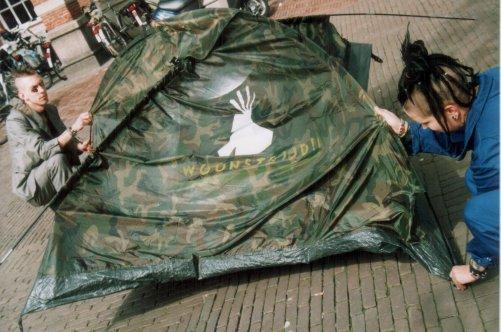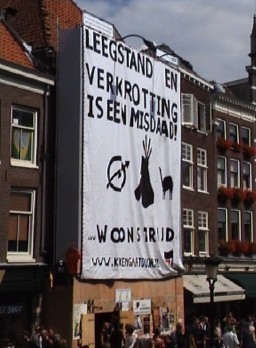.on Climate Camps
Over the past few years Climate Action Camps have sprung up around Europe
and around the world. Taking inspiration from the 2006 UK Camp for Climate
Action, the camps tend to bring together the aims education,
sustainability, direct action and movement. This summer EYFA got involved
with the first Dutch-Belgian Climate Action Camp and this newsletter is a
look back on it. You can also find links on the various other camps that
took place this summer at the bottom of the newsletter.
Dutch-Belgian Climate Action Camp
Early in the morning of August 1 2009 around one hundred activists from
Belgium and the Netherlands suddenly turned up at an empty field near
Berendrecht Belgium, 2 kilometers from the Dutch border, and next to
Antwerp's biggest coal transport hub. The empty field was quickly
occupied, with tents, compost toilets, a watersystem and kitchen all
constructed before daybreak. By August 3rd, alternative energy
installations, a kids space, a first aid tent, welcome tent, media bus,
legal team, workshop tents and composting systems were also up and
running. Welcome to the the first Dutch-Belgian Climate Action Camp.
During the week approximately 400 people attended the camp, including a
large 'anti-national' barrio/neighbourhood made up of people from all over
Europe and beyond, and a colourful and active kids barrio. More than fifty
workshops took place, five big actions were organised, the camp acted as
an example of sustainable living, and all the camp infrastructure was kept
running through collective effort and consensus decisions made by the
whole camp. Most of all, the camp and the occupation of the nearby coal
terminal inspired people to take action - towards the COP15 in Copenhagen
this December, and beyond.
Workshops
More than 50 workshops where held throughout the camp, allowing people to
learn about and share information and skills on the politics,
alternatives, solutions and dilemmas around climate change and the UN
Climate Talks in Copenhagen. From practical 'DIY' workshops on making your
own rocket stoves, to theoretical workshops on 'green capitalism,' and
panel discussions on 'movement building and strategy,' there was something
for everyone. The program also emphasised trainings, on everything from
planning an action or forming affinity groups, to learning facilitation
skills. And of course, the program wouldn't be complete without some
evening entertainment and post-action celebrations.
Sustainable Living
The Climate Camp was also an example of sustainable living. We showed that
it is possible, and encouraged people to experiment with and work towards
living comfortable, low-impact lives.
All the electricity used for lights, music, computers and projectors was
produced by solar cells, windmills and pedal generators on site. Many of
the building materials were scavenged or reused. Recycling and composting
systems were put in place from the first days, and functioned well
throughout the camp. We experimented with a greywater system, and the 10
compost toilets prevented the wastage of a huge amout of water, whilst
supplying a nearby organic farmer with manure.
The camp kitchen supplied 400 people with vegan and organic food. A vegan
diet requires one fifth of the energy needed to produce a meat-based diet,
and less than half of the energy required for a vegetarian diet, whilst
organic food is grown without oil-based pesticides and nitrogen
fertilsers.
And in the end, the camp site was left cleaner than we found it, to the
great suprise of the neighbourhood. This small, sustainable ecovillage was
a great contrast to what was visible on the other side of the canal: the
smoke stacks of petrochemical factories and a nuclear reactor. The camp
was about reducing our energy consumption, rediscovering communities,
rebuilding trust and localising our everyday lives – all key to
sustainability.
Photos of daily camp life (Indymedia.be):
http://www.indymedia.be/nl/node/34283 Camp Organisational Structure and Decision-Making
The Climate Action Camp was self-organised and DIY – everyone was
encouraged to help with the day-to-day running of the camp and to take
part in decision-making. Indeed, the camp was organised around the idea
that when we get rid of leaders and distribute power amongst ourselves, we
are able to take back control of our lives.
One method for sharing responsibility and power used at the camp was
consensus decision-making. From the first stages of planning through to
taking down the camp, decisions were made in open meetings where everyone
had the right to contribute and to be heard. By using consensus
decision-making everyone's views are heard and the group tries to find a
solution that addresses everyones concerns and desires. The result is
greater understanding between different individuals and groups, and
usually a better decision because everyone has thought carefully and
considered the possible alternatives, and hoepfully everyone who takes
part in the making of the decision feels that they had a stake in it and
therefore a stake in implementing it.
During the camp decisions took place during camp plenaries (ie action
planning) and daily site meetings (ie implementing new systems for
security or toilets or changing the daily schedule). The daily site
meetings involved individuals from various working groups ('work' based
groups open to anyone to join which took responsibility for various
aspects of the camp's operation, for example mediation, water, kitchen and
medics) and and individual from each barrio ('neighbourhoods' where
campers slept, often based on affinities such as where people were from or
a certain identity, ie the queer barrio). These individual representatives
changed on a daily basis, with the site meeting acting as a 'spokes
council' where each spoke or representative communicates the point of view
of their barrio and feeds back communication or decisions to their group.
But of course self-organising is not just about meetings. Doing It
Yourself means that if you see something needs doing, you don't ask "who
is responsible?," but just get on with making it happen! And as the camp
went on, this system worked remarkably well, with everyone getting stuck
in and making things work.
This is What a Climate Action Camp looks like (video from Indymedia.be):
http://www.indymedia.be/en/node/34384 Actions
Action trainings took place daily during the camp, and several actions
where organized with the camp as their base. This started on the first day
with a small occupation of the office of Delta, a Dutch energy company
that has announced plans to build a new nuclear reactor. Later in the
week, a battalion of the clown army launched an attack on Doel, the
nuclear reactor near Antwerp, and about 50 people went to the St.Anna
Forrest, just outside Antwerp to warn people that it is threatened by the
construction of a new part of the ringroad and the megalomanic Lange
Wapper Bridge. On August 6th a supermarket in Antwerp was surprised by a
group of people closing down the meat section, and informing people about
the link between meat and climate change.
As the week went on, more and more people were involved in an open and
democratic process to make the plans for Friday's mass action. The aim was
to close down the Antwerp Bulk Terminal (ABT), and to openly annouce it in
advance. The ABT supplies most of the coal plants in Belgium, and some in
the Netherlands and Germany with coal imported form the US, Colombia and
South Africa. Eight megatons of coal leaves the ABT every year on boats
and in trains.
What started as a rough proposal for the mass action was worked out in
plenary meetings by everyone who wanted to be involved. Eventually, a
framework was created where a number of different affinity groups could
make their own plans as one part of the bigger action. The affinity groups
were supported with a legal team, training and the media team of the camp.
This way about 200 people could not only join the action, but decide how
it was going to look like from the start. For many of the people involved
it was their first big direct action.
On the Friday morning several small groups entered the ABT site much
earlier than the suprised police forces were expecting, chaining
themselves to rails and conveyor belts. The police and the company running
ABT threatened the activists with a court order, claiming that each person
blocking the site would be fined 10,000 – 20,000 euros per hour. Most
groups retreated and tred to block the huge terrain somewhere else,
thereby sending a coal boat and a coal train away. By the time the first
small groups had to give up their action, two large groups left the camp,
and started making their way through the woods towards the ABT. Meanwhile,
the "kids block," constisting of about 50 kids and parents, left the camp
on the front side. The larger groups managed to enter the terrain and
occupy it for a couple of hours, before riot police pushed them off the
terrain. During the action about 11 people where arrested.
Action against Lange Wapper bridge in Antwerp:
http://www.youtube.com/watch?v=dYwyWhpcPIg Action against meat industry:
http://www.youtube.com/watch?v=L-e1Z-TOEeY Clown action against nuclear energy:
http://www.youtube.com/watch?v=nzUWhrT2KFA Clown action against nuclear energy:
http://www.youtube.com/watch?v=3Cp0qJPdrZg ATV video on the direct action against coal hub ABT:
http://www.atv.be/v3/newsdetail.aspx?mid=&id=13254 More video of the coal terminal blockade:
http://www.youtube.com/watch?v=gZ3z8gDKukg&feature=related Towards Copenhagen and Beyond...
The camp and the mass action laid the basis for a strong mobilization
towards the COP15 in Copenhagen this December, where massive actions are
planned to stop the ineffective, capitalist solutions to the climate
crisis, advocated by governments and corporations ( see more at
www.climate-justice-action.org). Mobilisation groups from both Belgium and
the Netherlands formed at the camp, and are now busy organising people at
home to get involved.
Perhaps the biggest result of the camp was to inspire action; in
Copenhagen, at home, and in the coming years. For many it was their first
experience with direct action, leaving them with a taste for more. The
camp also functioned as a great networking meeting, linking up people to
fight the climate crisis, to share ideas and to come up with new ideas.
People are already thinking about ideas for a camp next year...
More Links From the Camp
Video of
indymedia.be about the first three days of the climate action camp:
http://www.youtube.com/watch?v=mDVEm8QbRcY NOS video on the climate action camp:
http://www.youtube.com/watch?v=JwyR0jwsLvY Other Climate Camps
Climate Camp Australia
http://www.climatecamp.org.au/ Climate Camp Cymru (Wales):
http://climatecampcymru.org Climate Camp Denmark
http://camp09.dk Climate Camp France
http://www.campclimat.org Climate Camp Ireland
http://www.climatecamp.ie Climate Camp New Zealand
http://www.climatecamp.org.nz Climate Camp Scotland
http://climatecampscotland.org.uk/ Climate Camp South Australia
http://www.climatecampsa.org Climate Camp UK
http://www.climatecamp.org.uk Other Action Camps
Reclaim the Fields – Via Campesina
http://reclaimthefields.org/ Ecological Camp Against Coal – Ukraine
http://www.allvoices.com/contributed-news/4113978-ecological-camp-in-sevastopol _______________________________________________
Network mailing list
Network@lists.eyfa.org https://lists.eyfa.org/mailman/listinfo/network 













